The Freedom Riders intended to draw attention to?
In 1961, Freedom Riders rode between cities in the American S to examination federal laws banning racial segregation. They were arrested, threatened, and beaten senseless.
Police guarding a bus final during Freedom Riders' demonstration. Lynn Pelham/The LIFE Images Drove/Getty Images
Black and white Freedom Riders on their way to Jackson, Mississippi. The original Liberty Riders group consisted of seven blackness riders and half-dozen white riders. Paul Schutzer/The LIFE Picture Collection/Getty Images
An unidentified Freedom Rider purchases a bus ticket at the bus station in Montgomery, Alabama. Despite the Supreme Courtroom ban on racially-segregated seating on buses, many states and cities connected the racist practice. Paul Schutzer/The LIFE Picture Collection/Getty Images
Freedom Riders gasping from teargas bombs that were thrown into the church building where they were meeting. A. Y. Owen/The LIFE Images Drove/Getty Images
A National Guardsman escorts Freedom Riders and their supporters home subsequently their church was taken over by a mob in Montgomery, Alabama. Paul Schutzer/The LIFE Picture Collection/Getty Images
Freedom Riders put their hands together in prayer at a safe firm after existence rescued from First Baptist Church building in Montgomery, Alabama. Paul Schutzer/The LIFE Premium Drove/Getty Images
A Freedom Rider looks out the the bus window as the grouping travels through Montgomery. Paul Schutzer/The LIFE Premium Collection/Getty Images
Freedom Riders relaxing in a prophylactic firm. Getty Images
An unidentified Liberty Rider cranes his head out of the window of an interstate motorbus as a National Guardsman stands lookout man outside. The group was given a military escort by the federal regime after tensions flared in the deep South. Paul Schutzer/The LIFE Picture Drove/Getty Images
A Liberty Rider smokes a cigarette as she sits on a bus and looks out of the window. While in that location were a scattering of women participating in the interstate bus rides among the dissimilar groups of Liberty Riders, there were only two women who were part of the original 13-person group under Core. Paul Schutzer/The LIFE Moving-picture show Collection/Getty Images
A National Guardsmen stands scout outside a Liberty Passenger'south charabanc. Getty Images
Liberty Riders sleep during their passenger vehicle ride from Montgomery, Alabama, to Jackson, Mississippi. The initial Freedom Riders campaign lasted 20 days. Lee Lockwood/The LIFE Images Collection/Getty Images
Liberty Riders and supporters sleep in the church pews under the instructions of the grouping's military escort. Paul Schutzer/The LIFE Motion picture Collection/Getty Images
A group of Freedom Riders enter the "white waiting room" at a passenger vehicle terminal in Jackson, Mississippi. The Freedom Riders sought to challenge the connected segregation and racism against black passengers despite the Supreme Court's ban of these practices. Paul Schutzer/The LIFE Picture Drove/Getty Images
Just earlier dawn, the National Guard moves into Kickoff Baptist Church, where there was a meeting to honor and pray for the young travelers, and moved the congregation out. Paul Schutzer/The LIFE Premium Drove/Getty Images
A church building congregation praying for Liberty Riders and their supporters. The Liberty Riders experienced extreme violence from racist pro-segregationists for their efforts to desegregate the public transportation system. Getty Images
Freedom Riders relax, regroup, and heal (note the bandage on the back of now-Congressman John Lewis' s head) after being rescued from First Baptist Church in the rubber house in Montgomery. Paul Schutzer/The LIFE Premium Collection/Getty Images
Constabulary and National Guardsmen escorting Freedom Riders. Lynn Pelham/The LIFE Images Collection/Getty Images
Churchgoers praying for the condom of 400 Freedom Riders traveling between states. Paul Schutzer/The LIFE Movie Collection/Getty Images
Liberty Riders and Rev. Metz Rollins speaks with the media as a National Guardsman stands sentry. Joe Scherschel/The LIFE Picture Collection/Getty Images
A U.Southward. Army truck takes Freedom Riders abroad from a church rally back to their homes after an angry mob besieged the church. The Liberty Riders rode buses throughout the Deep Due south to test and call attention to notwithstanding-existing local policies that ran contrary to national laws. Photo by Paul Schutzer/The LIFE Motion picture Drove/Getty Images
View through the window of the "Colored Waiting Room"of Freedom Riders as they look in a charabanc station in Montgomery, Alabama. Paul Schutzer/The LIFE Picture Collection/Getty Images
Alabama guardsmen circle around the Liberty Riders bus. Paul Schutzer/The LIFE Picture Drove/Getty Images
Freedom Riders having a meal at the Montgomery safe house. Getty Images
Martin Luther Male monarch, Jr. and others greet Freedom Riders most to board a autobus in Montgomery. As public tensions surrounding the desegregation movement grew, MLK continued to show his public support for the activists on the Freedom buses. Paul Schutzer/The LIFE Picture Collection/Getty Images
Martin Luther King, Jr. talks with Freedom Riders. Paul Schutzer/The LIFE Picture Collection/Getty Images
MLK during a rally for Freedom Riders in Jackson, Mississippi, the last stop on the group's initial 20-twenty-four hours-long campaign for desegregation. Paul Schutzer/The LIFE Pic Collection/Getty Images
Liberty Riders on the charabanc through Alabama. The activists were met with attacks of violence from racist segregationists who burned their buses and beat the riders. Paul Schutzer/The LIFE Pic Collection/Getty Images
A National Guardsman stands past Rev. Metz Rollins on the Liberty Riders bus. Paul Schutzer/The LIFE Movie Drove/Getty Images
National Guardsmen were assigned to travel with the Freedom Riders post-obit bouts of attacks from white supremacists who were anti-desegregation. Getty Images
National Guardsmen standing in a line on a sidewalk every bit they wait for Freedom Riders on an interstate bus to embark. Getty Images
Liberty Rider Julia Aaron having a chat with a police officer. Getty Images
Rev. Metz Rollins and another Freedom Passenger sit in silence on the bus. Getty Images
An ground forces truck take people from a church rally for the Freedom Riders after a mob besieged the church. The church was supposed to be a place of refuge after the group had been attacked in the previous weeks. Paul Schutzer/The LIFE Picture Collection/Getty Images
The view from a bus window during the trip from Montgomery, Alabama to Jackson, Mississippi. Paul Schutzer/The LIFE Premium Collection/Getty Images
Rev. Ralph Abernathy is questioned past two constabulary officers during one of the Freedom Rides. Paul Schutzer/The LIFE Moving-picture show Collection/Getty Images
A group of white men in suits carrying bats on their way to confront the Freedom riders. Getty Images
National Guardsmen stand watch while a Liberty Passenger walks in front of 1 of the Freedom buses. Paul Schutzer/The LIFE Flick Drove/Getty Images
National Guardsmen property guns and standing alongside a road during the Freedom Passenger crisis. They were dispatched by and so-Attorney General Robert Kennedy to protect the activists amidst growing attacks confronting them and the desegregation move. Getty Images
National Guardsmen lining the sidewalk and levels of a parking garage to protect the Freedom Riders. Getty Images
A family watches a boob tube report almost the Freedom Riders as the group enters Alabama. Paul Schutzer/The LIFE Film Drove/Getty Images
White Liberty Rider recovering in his hospital bed afterwards getting beaten past anti-integration supporters, who were also mostly white. Donald Uhrbrock/The LIFE Images Collection/Getty Images
A blackness protester gets kicked downwardly by a white human being during Freedom Rider demonstrations. Donald Uhrbrock/The LIFE Images Collection/Getty Images
An unwelcoming group of anti-integrationists gathering not far from the Freedom Riders and their passenger vehicle. Getty Images
Winonah Margaret Beamer, age 19. Beamer was arrested at 5:35 a.grand. at Jackson, Mississippi'southward central depot later arriving from Nashville. Matt Loughrey/My Colorful Past
William Edd Harbour, age nineteen. Harbour was expelled from his Tennessee college due to his participation in the Liberty Rides. Matt Loughrey/My Colorful Past
Patricia Elaine Bryant, age 20. Bryant was a member of the 12th group of Freedom Riders that were arrested in Jackson, Mississippi, coming from Nashville, at 5:30 a.m. Matt Loughrey/My Colorful By
Jorgia Siegel, age 19. She was arrested for a alienation of the peace and for sitting next to a black person on a bus. She spent 40 days in jail. Matt Loughrey/My Colorful Past
John Luther Dolan, age 20. Dolan was a fellow member of the CORE in 1961. Age 20 Dolan Was A Member Of The Core In 1961. Matt Loughrey/My Colorful Past
Joan Trumpauer Mulholland, age 19. For 2 months, she was held with other ceremonious rights activists on Parchman Penitentiary's death row. Matt Loughrey/My Colorful Past
Helene Dorothy Wilson, age 26. Wilson worked as an activist with the Irenic Action group and the Congress of Racial Equality. Matt Loughrey/My Colorful Past
David Kerr Morton, age 21. Morton was arrested at the Jackson, Mississippi motorcoach depot for trying to order a meal in the Negro section. Matt Loughrey/My Colorful Past
Claire O'Connor, age 22. O'Connor was a student at the Academy of Minnesota when she was arrested in Jackson, Mississippi for her participation in a Liberty Ride. Matt Loughrey/My Colorful By
Kredelle Petway, age 20. Petway was a student at Florida A & M University in Tallahassee when she was arrested for her participation in the Freedom Rides during the summer of 1961. Matt Loughrey/My Colorful Past
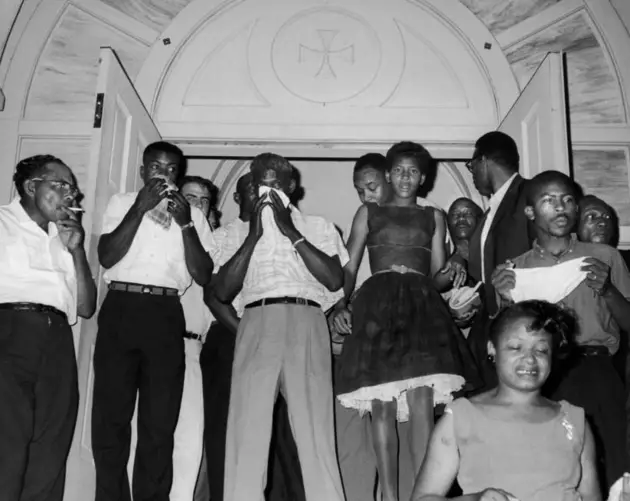
When The Freedom Riders Rode Through The South For Racial Equality — And Faced Violence
The Freedom Riders were a mixed group of African-Americans and white people who rode between cities in the deep Due south to test federal laws banning segregation on interstate public transit. While information technology was illegal to have racially-segregated seats on buses and at charabanc stops later on the police force passed, in reality the constabulary was mostly ignored.
The 20-day trip betwixt Washington, D.C., to Jackson, Mississippi commanded the nation's attention after the Liberty Riders were attacked and beaten by racist pro-segregationists.
In a larger sense, these interstate bus rides were about more than securing a seat for blackness passengers. It was a symbol of the growing resistance from African-Americans and allies confronting the mean fire of the nation'southward systemic racism.
Desegregation Of Public Transportation
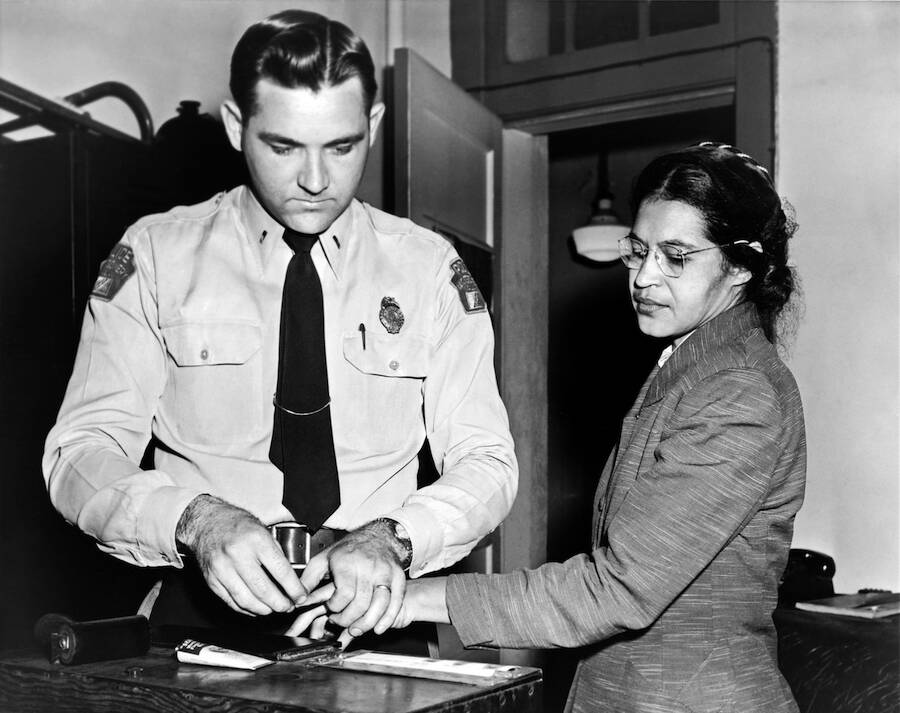
Underwood Archives/Getty Images Rosa Parks gets fingerprinted after her arrest.
The Liberty Riders campaign cannot be explored without first understanding the history of bus desegregation in America.
Many will say the moment that propelled the movement was on December. 1, 1955, when an African-American customs activist named Rosa Parks got on the bus dwelling house afterwards a long day of work and refused to give upward her seat to a white passenger when the bus driver told her to.
At the time, motorcoach drivers in Montgomery, Alabama, routinely required African-Americans to surrender their seats to white passengers if the whites-merely section of the omnibus was full.
Later Parks, who served as the secretary for the National Association for the Advancement of People of Color (NAACP), was taken into custody, local activists began mobilizing for a boycott of the city's bus organization.
Members of the Women'south Political Council (WPC), an activist organization made upwardly of black women professionals, had been advocating for the disinterestedness of Montgomery's blackness motorcoach passengers years before Parks' bus seat incident.
But the grouping saw the incident as an opportunity to advance their civil rights piece of work past using Parks' arrest as a catalyst to mobilize residents the same day that Parks was tried in municipal courtroom. Black leaders and ministers besides helped promote the planned boycott. The Montgomery Advertiser put out an article most the cold-shoulder on its front page.
The result? Thousands of African-Americans boycotted the urban center's bus system; the city lost between thirty,000 and twoscore,000 bus fares each mean solar day of the cold-shoulder. Volunteers helped bulldoze boycotters to and from work while black taxi drivers charged x cents a ride — the aforementioned corporeality as bus fare — to support the protest.
"It was the best way I could contribute," said Samuel Gadson, who endured harassment for driving boycotters in his 1955 Ford, said.
The blackness riders made up the bulk of bus passengers, so this put huge pressure on the public transit arrangement.
Enter Martin Luther King
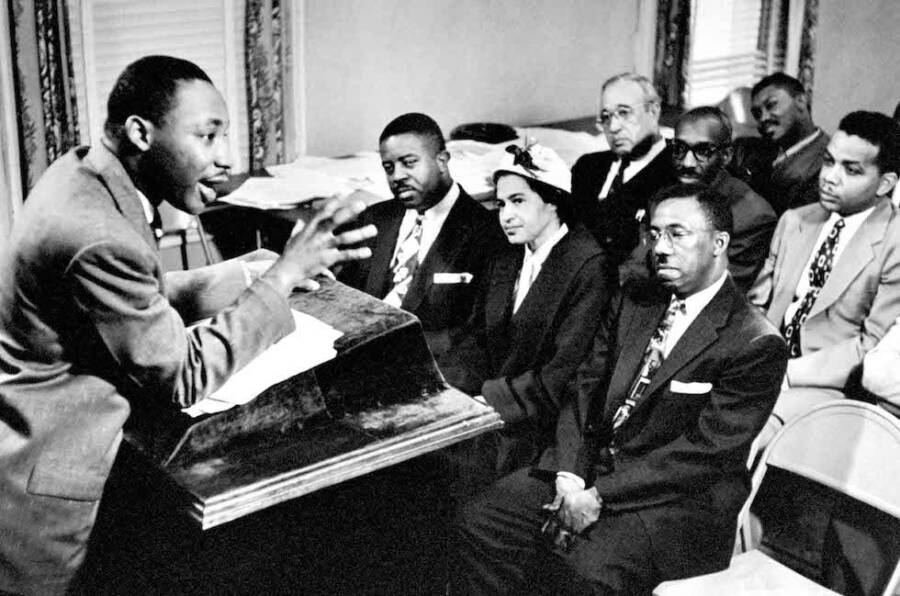
Don Cravens/The LIFE Images Collection via Getty Images/Getty Images Rev. Martin Luther King, then director of the Montgomery jitney boycott, outlines strategies to organizers, including Rosa Parks.
A young, black pastor named Martin Luther King, Jr. — who had recently get the pastor of the Dexter Artery Baptist Church in Montgomery — became the face up of the boycott and continued to lead it until the urban center met the demands of local blackness leaders.
These demands did non seek to repeal the metropolis's segregation ordinance just rather focused on ceremonious decency toward black passengers. Firstly, the group demanded the city alter its method of dividing the double-decker by race.
Equally information technology was, the racial dividing line was fluid; a omnibus driver could motion it to whichever row he wanted. Earlier Rosa Parks was arrested, she had been sitting in the "colored" section of the bus — it was only afterwards more than white people got on and the motorbus driver moved the dividing line dorsum that she was sitting in the white section. That's when she refused to move.
Under the group'southward proposal — a compromise they idea the city would be more than likely to accept — no blackness rider would always be forced to give upwardly their seat for a white passenger. If the white department filled upward, and then white passengers would be forced to stand.
The group, dubbed the Montgomery Improvement Association, too demanded the city rent black drivers and institute a first-come, commencement-seated policy.
Simply the city didn't budge. Information technology was and so that a group of five African-American women filed a joint lawsuit against the city in federal courtroom seeking to take Montgomery's bus segregation laws abolished completely, in a case called Browder v. Gayle.
After an appeal by the city, the Supreme Court decided to uphold the determination of the lower court that had ruled whatever laws requiring racially segregated seating to be in violation of the 14th Amendment.
Following the Supreme Court decision, Montgomery'southward buses were integrated on December 21, 1956, and the motorbus boycott finally ended after 381 days.
Although segregated seating had been outlawed, racial tensions continued to flare in Montgomery. Violence against black passengers intensified with sniper hail burn down attacking buses and injuring blackness riders.
Just a few weeks after the Supreme Court decision to integrate the public bus organisation, four black Montgomery churches and the homes of prominent local black pastors in were bombed. The law afterwards arrested several Ku Klux Klan members for the bombings, but all were acquitted by all-white juries.
Blackness passengers were also still unwelcome in predominately white spaces at bus stations, where waiting facilities for white passengers and black passengers remained separate. While the law did away with bus segregation on newspaper, it was articulate that in reality there was much piece of work left to exist done.
The Freedom Riders
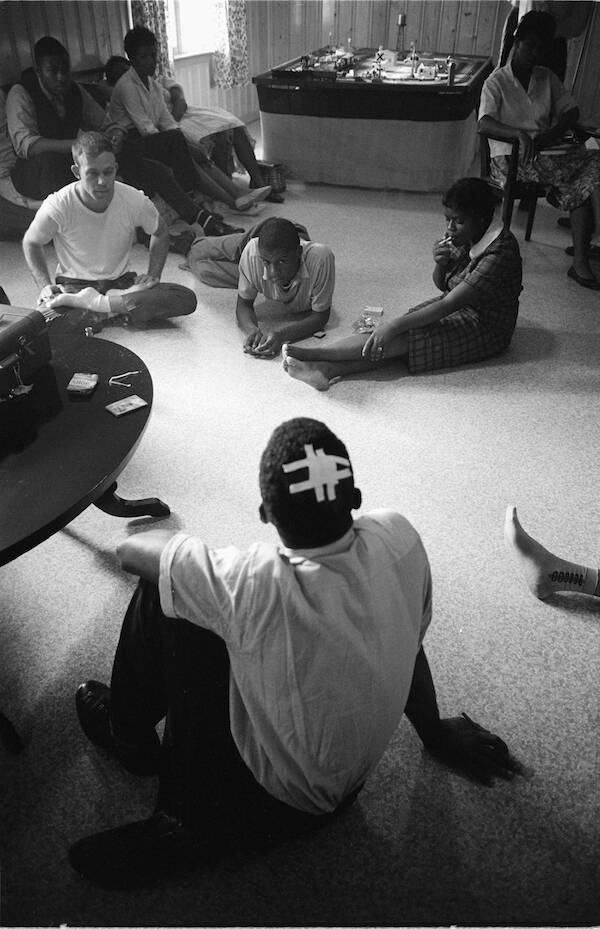
Paul Schutzer/The LIFE Premium Drove/Getty Images The Freedom Riders regroup after existence rescued from the white mob surrounding Start Baptist Church.
By the early 1960s, the civil rights movement had gained tremendous momentum. Civil rights activists and students were staging protests everywhere, including sit down-ins at the segregated tiffin counters at public restaurants.
Non-violent and peaceful protest was the soul of the civil rights movement, a method promoted by Martin Luther King, Jr. in his pursuit of racial equality.
In a November 1960 televised debate with a pro-segregationist on NBC titled "Are Demonstration Strikes Justifiable?," Male monarch explained the rationale behind these peaceful protests:
"We come across here a cause without violence, and there is no attempt on the part of those who engaged in sit down-ins to annihilate the opponent only to convert him. There is no attempt to defeat the segregationists but to defeat segregation, and I submit that this method, this sit-in movement, is justifiable because information technology uses moral, humanitarian, and effective means in gild to achieve the effective end."
The influence that these protests diameter would exist tested in May 1961, when caravans of Liberty Riders drove between states in the infamously racist deep South to bring awareness to the segregationist practices that notwithstanding permeated public transit — fifty-fifty after it was legally banned by the federal regime.
Riding For Freedom
Members of the KKK were arrested following the assail on the Freedom Riders buses in Alabama.
All the way back in 1946, in Morgan v. Virginia, the Supreme Court ruled that Virginia's police enforcing segregation on interstate buses was unconstitutional. The commencement Liberty Rides happened the adjacent year, in fact, to exam the new police. Simply there were no confrontations, and so the protests garnered very piddling media attention.
That inverse 14 years afterward. In Dec 1960, in Boynton v. Virginia, the Court went a stride further, banning segregation in bus terminals serving interstate passengers. At this indicate, desegregation was the hottest of hot-push button bug. Black resistance — and white supremacy — were on the rise. And despite rulings from the highest courtroom in the land, Jim Crow remained in full forcefulness in the south.
And and then a group of activists saw their entry bespeak.
On May 4, 1961, the Congress Of Racial Equality (Cadre), a civil rights arrangement founded on the principles of non-violence promoted by Indian activist Mahatma Gandhi, sent 13 of its members — seven black and six white — to ride on two separate public buses from Washington, D.C. to the deep South.
Over the next several months, Core'south ranks would aggrandize past more than than 400 volunteers, all of whom were trained to endure extreme acts of opposition — similar existence spat on, hit, or screamed at with racial epithets — and remain non-vehement.
Making History
The Freedom Riders endured hostile treatment during their trip through the segregated southern states.
According to Cadre director James Farmer, the goal of the Liberty Riders campaign was "to create a crisis then that the federal authorities would be compelled to enforce the law."
It sure seemed like a crisis — at least by the time they reached Due south Carolina.
On May 9, John Lewis, who was black, and Albert Bigelow, who was white, entered a Greyhound coach station in Rock Hill, Southward Carolina labeled "whites only."
In the first major act of resistance the Riders faced, Lewis — who is now a U.Due south. congressman from Georgia — was promptly beaten and bloodied by a white homo. The homo busted his lip open and cutting his face up, and the fell beating made the news.
"All along the way we saw these signs that said white waiting, colored waiting, white men, colored men, white women, colored women," Lewis recounted of the dangerous trip. "Segregation was the guild of the day."
Equality for African-Americans would never be won easily that much was certain, but the violence confronting them had just just begun. The attacks they endured in Anniston, Alabama shocked the nation.
On May fourteen, a mob of angry white segregationists blocked i of the Liberty Riders' buses, attacking it with rocks, bricks and firebombs.
They chanted "Burn down them alive!" and "Fry the goddamn n—!" while slashing the bus'due south tires. Even when the autobus erupted in smoke and flames, mobsters blocked the door and then the passengers couldn't exit.
Luckily, the inflow and alarm shots from country troopers pushed the racist mob away. But simply a few hours later, more than black and white Riders were beaten after entering the whites-only restaurants and waiting rooms at the jitney terminals in Anniston and Birmingham.
Despite the bloody attacks, many of the volunteers persevered and were adamant in continuing their Freedom Ride through the Deep Due south.
"We were adamant not to allow whatsoever act of violence keep us from our goal," Lewis said. "Nosotros knew our lives could exist threatened, but we had made up our minds non to plough back."
Robert F. Kennedy Orders Military Convoy For Riders
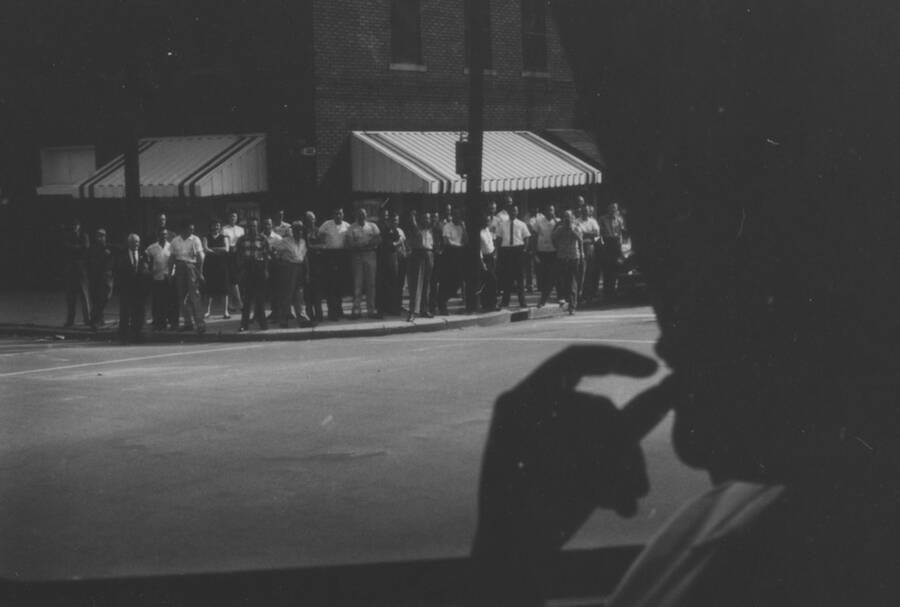
Getty Images A mob of anti-integrationists as seen through a window of a Freedom Riders' motorcoach.
The attacks on the Freedom Riders in Alabama left many of them bruised and injured: a white Rider named Jim Peck suffered severe injuries subsequently he was beaten, and received 56 stitches to his head.
Diane Nash, the chairperson of the Student Irenic Coordination Commission (SNCC) behind the famous Nashville sit-ins, took over the responsibilities for the Freedom Ride and recruited x of her own members to choice upward the mission and continue the ride to Jackson, Mississippi.
The physical attacks against the Freedom Riders had defenseless enough press attention that it finally reached the White House. At the head of the U.Southward. Justice Department that time was Robert F. Kennedy, the brother of so-President John F. Kennedy.
The violence that erupted in Alabama was enough for the attorney general to order his second-in-command, John Seigenthaler, to become in touch on with Nash. The government wanted the activists to finish the campaign, going as far as offer the activists money in exchange for halting the Freedom Rides.
Activists knew that without strong enforcement and support from the federal regime, things were never going to change, not fifty-fifty under Attorney General Kennedy.
"Everywhere but Alabama, and Mississippi, and Georgia," historian Raymond Arsenault noted. At that time, the Kennedy brothers even so depended on the Democratic votes from the s.
"We had made it that far without their coin, and so I wanted to stay independent. The Kennedys were in the executive co-operative of regime, and it was their job to enforce the law," Nash told the press decades afterward.
"If they had washed their job we wouldn't have to have been risking our lives."
Southbound
Oprah Winfrey meets the Freedom Riders who survived a KKK set on
The Freedom Riders continued to Montgomery, Alabama, and stopped for a hole-and-corner mass meeting at the local Beginning Baptist Church building, led by Rev. Ralph Abernathy. King greeted the activists, rallying them to continue their journey through the state.
The Liberty Riders disguised themselves every bit members of the church choir and managed to blend in with the local churchgoers. Only word presently got out of the Freedom Riders' presence and an angry white mob slowly formed around the church. King personally chosen the attorney full general to ask for protection for the Liberty Riders to foreclose more mortality.
The government issued a presidential gild to have the National Guard sent to Montgomery and escort the Freedom Riders on the rest of their journey to Jackson, Mississippi.
Notably, even after decades of atrocities faced past blacks in the South at the hands of the KKK and state and local administrations, the federal regime wasn't compelled to human activity until white civil rights activists — not only black ones — faced violence and angry mobs.
Former Freedom Rider Peter Ackerberg, who joined the ride in Montgomery, said that while he'd always talked a "large radical game," he had never acted on his convictions before joining the Riders.
"What am I going to tell my children when they ask me well-nigh this time?" Ackerberg remembers thinking. "I was pretty scared... The black guys and girls were singing.... They were so spirited and then unafraid. They were actually prepared to risk their lives."
Ane of the all-time-known anthems that has become emblematic of the civil rights move — even outside the U.South. — was the song "We Shall Overcome," which was also adopted as the go-to canticle among black and white Freedom Riders singing on the bus.
Locked Up In Jackson
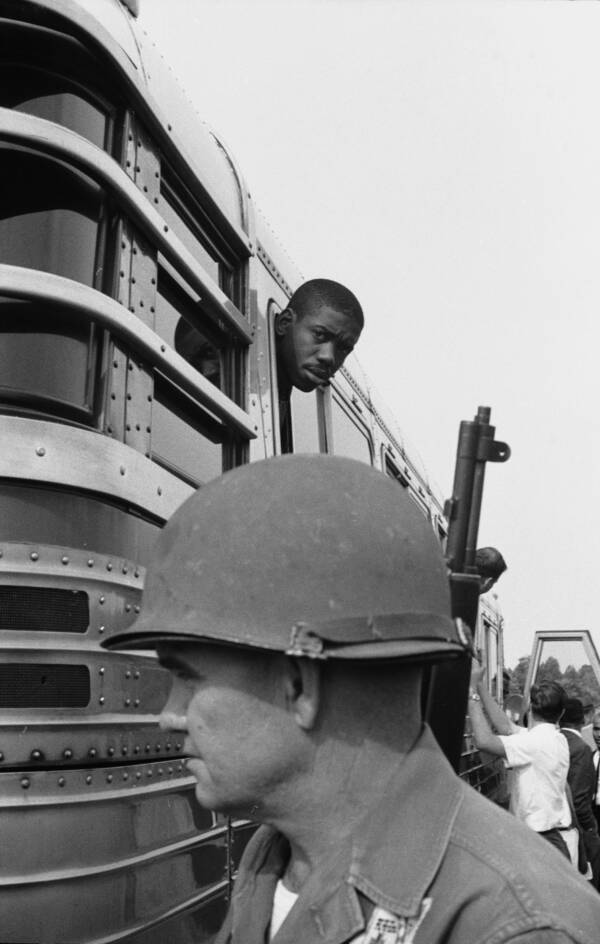
Paul Schutzer/The LIFE Flick Collection/Getty Images Freedom Riders were assigned a convoy of National Guards to protect the activists from being attacked by pro-segregationists.
When Freedom Riders finally arrived at the Jackson, Mississippi passenger vehicle station, 306 of them were arrested by the law for "alienation of peace" subsequently they refused to stay out of white restrooms and facilities. White Freedom Riders were besides arrested subsequently deliberately using facilities meant for blackness passengers only.
Many of them were locked up in Parchman, Mississippi'southward worst prison, for weeks, where they endured appalling treatment and conditions; some of them were slapped or beaten for not addressing the prison guards as "sir".
"The dehumanizing procedure started as soon every bit we got in that location," said onetime Freedom Rider Hank Thomas, who was then a sophomore at Howard University.
"Nosotros were told to strip naked and then walked downwardly this long corridor....I'll never forget [Core Director] Jim Farmer, a very dignified man...walking down this long corridor naked....That is dehumanizing. And that was the whole point."
Finally, afterward many more Freedom Ride protests throughout the segregated S in the ensuing months, Robert Kennedy issued an official petition to enforce regulations confronting segregated bus facilities. Every bit a issue, the Interstate Commerce Committee enacted tougher regulations and revved up reinforcement of the segregation ban in November 1961. The new laws were enforced by fines of up to $500 (or more than than $four,000 in today'south dollars).
To this twenty-four hours, the Liberty Riders movement continues to be a beacon of societal change and the principles of pursuing justice, no matter what the toll may be.
In fact, in 2009, just after President Barack Obama became the first black president of the United states, the homo who crush Rep. John Lewis senseless 48 years prior, went to Washington D.C. and apologized to Lewis.
Edwin Wilson apologized to Congressman and Freedom Passenger John Lewis 48 years afterwards chirapsia him in a South Carolina passenger vehicle station.
"Information technology was wrong for people to be similar I was," said Elwin Wilson, who died in 2022. "But I am non that man anymore."
"I forgive y'all," Lewis said. "Information technology is good to meet yous, my friend."
Afterward learning about how the Freedom Riders risked their lives to button for greater enforcement of desegregation laws, take a await at 55 powerful photos that relive the civil rights movement. Then, read nigh 4 female ceremonious rights leaders y'all didn't learn nigh in school.
Source: https://allthatsinteresting.com/freedom-riders
Posted by: kirbythimakeent.blogspot.com


0 Response to "The Freedom Riders intended to draw attention to?"
Post a Comment